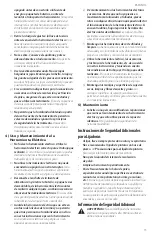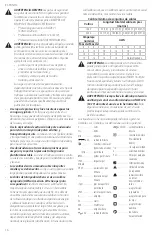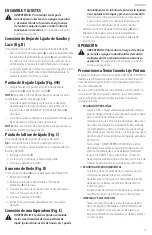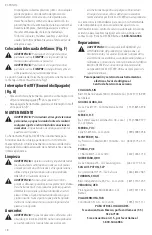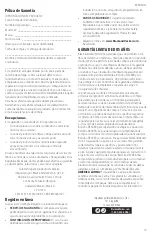
5
English
ASSEMBLY AND ADJUSTMENTS
WARNING: To reduce the risk of serious personal
injury, turn unit off and disconnect it from
power source before making any adjustments or
removing/installing attachments or accessories.
An accidental start‑up can cause injury.
Connecting a Vacuum Cleaner (Fig. E)
WARNING: Collected sanding dust from sanding
surface coatings (polyurethane, linseed oil, etc.)
can self ignite in sander dust bag or elsewhere
and cause fire.
To reduce risk, empty bag frequently
and strictly follow sander manual and coating
manufacturer’s instructions.
• Fit the dust extraction connector
2
onto the adapter at
the back of the tool.
• Connect the hose of a suitable vacuum cleaner to
the connector.
Finger Attachment (Fig. D)
The finger attachment
6
is used for fine detail sanding.
1. Remove the screw
7
.
2. Remove the diamond-shaped tip holder
4
from the base.
3. Fit the finger attachment onto the sanding base as
shown in Figure D.
4. Fit and tighten the screw.
5. Align the appropriate sanding sheet with the
finger attachment.
Replacing Diamond Shaped Pad Tip (Fig. C)
When the sanding base tip
5
or tip holder is worn, it can be
replaced. Spare parts are available from your BLACK+DECKER
dealer.
1. Remove the screw
7
.
2. Reverse or replace the worn part.
3. Fit and tighten the screw.
Attaching Hook and Loop Sanding Sheets
(Fig. B)
For best results, use BLACK+DECKER accessories.
• To attach the sanding sheet
9
, carefully center the sheet
over the sanding pad
3
ensuring the holes in the disc align
with the holes in the pad and press the sheet firmly in place.
• The hook and loop fastening system sanding sheet
can be easily removed by simply pulling it off. It can be
reused as desired.
Sanding Sheet Tips (Fig. ###)
• Detach the two additional diamond-shaped tips
8
from
the sanding sheet
9
nOTE:
The diamond-shaped tip can be reversed and
replaced when worn.
• When the front part of the tip is worn, detach it from the
sheet, reverse it and press it onto the diamond-shaped pad
tip
5
again.
• When the whole tip is worn, remove it from the sanding
base and fit a new tip.
nOTE:
For optimal dust collection, ensure the correct type of
sanding paper is used.
The label on your tool may include the following symbols. The
symbols and their definitions are as follows:
V ......................... volts
Hz .......................hertz
min .....................minutes
or DC ......direct current
...................... Class I Construction
(grounded)
…/min ..............per minute
BPM ....................beats per minute
IPM .....................impacts per minute
OPM .................... oscillations per
minute
RPM .................... revolutions per
minute
sfpm ................... surface feet per
minute
SPM ....................strokes per minute
A .........................amperes
W ........................watts
Wh ......................watt hours
Ah .......................amp hours
or AC ...........alternating current
or AC/DC .... alternating or direct
current
...................... Class II Construction
(double insulated)
no .......................no load speed
n .........................rated speed
PSI....................... pounds per square
inch
......................earthing terminal
.....................safety alert symbol
..................... visible radiation
do not stare into
the light
..................... wear respiratory
protection
..................... wear eye protection
..................... wear hearing
protection
..................... read all
documentation
WARNING:
Use of this tool can generate and/or
disperse dust, which may cause serious and permanent
respiratory or other injury. Always use NIOSH/OSHA
approved respiratory protection appropriate for
the dust exposure. Direct particles away from face
and body.
WARNING: Always wear proper personal hearing
protection that conforms to ANSI S12.6 (S3.19)
during use.
Under some conditions and duration
of use, noise from this product may contribute to
hearing loss.
size to use depending on cord length and nameplate
ampere rating. If in doubt, use the next heavier gauge. The
lower the gauge number, the heavier the cord.
Minimum gauge for Cord sets
Volts
Total length of Cord in Feet
(meters)
120 V
25 (7.6)
50 (15.2) 100 (30.5) 150 (45.7)
240 V
50 (15.2) 100 (30.5) 200 (61.0) 300 (91.4)
Ampere Rating
American Wire gauge
More
Than
not
More
Than
0
6
18
16
16
14
6
10
18
16
14
12
10
12
16
16
14
12
12
16
14
12
Not Recommended
Содержание MOUSE BDEMS230
Страница 4: ...2 Fig B Fig C Fig D Fig E Fig F 8 9 4 4 3 7 7 5 10 6 2 ...
Страница 22: ......
Страница 23: ......
Страница 24: ...NA076584 09 21 Black Decker U S Inc 701 East Joppa Road Towson MD 21286 Copyright 2021 ...

















